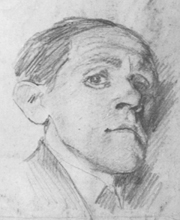
Bruno Schulz 1892-1942
biography
He was small, unattractive and sickly, with a thin angular body and brown, deep-set eyes in a pale triangular face. He taught art at a secondary school for boys at Drohobycz in South Eastern Poland, where he spent most of his life. He had few friends outside his native city. In his leisure hours he made drawings, etchings on photographic plates and wrote endlessly. At the age of forty, having received an introduction through friends to Zofia Nalkowska, a distinguished novelist in Warsaw, he sent her some of his stories. They were published in 1934 under the title Cinnamon Shops (known in the United States as Streets of Crocodiles). Three years later, a further collection of stores, with drawings by the author, Sanatorium Under the Sign of the Hourglass, was published; the The Comet, a novella, appeared in the leading literary weekly. In between, Schulz made a translation of Kafka's The Trial. It is said that he was working on a novel, entitled The Messiah, but nothing remains of it. These two books, drawings and novella are the sum total of his artistic output.
Bruno Schulz was shot in the streets of Drohobycz in November of 1942. Schulz was bringing home a loaf of bread when he was killed by a Gestapo officer who had a grudge against another Nazi, Schulz's temporary "protector" who liked his paintings.
When Bruno Schulz's stories were re-issued in Poland in 1957, translated into French and German, and acclaimed everywhere by a new generation of readers to whom he was unknown, attempts were made to place his oeuvre in the mainstream of Polish literature, to find affinities, derivations, to explain him in terms of one literary theory or another. The task is nearly impossible. He was a solitary man, living part, filled with his dreams, with memories of his childhood, with an intense, formidable inner life, a painter's imagination, a sensuality and responsiveness to physical stimuli which most probably could find satisfaction only in artistic creation - a volcano, smoldering silently in the isolation of a sleepy provincial town.
In 1987, The Brothers Quay (animators and filmmakers) created an animated (puppetry and stop motion) version of Streets of Crocodiles
selected works in translation
Complete Fiction of Bruno Schulz translated by Celina Wieniewska (Walker and Company, 1989)
writing
excerpt from - Streets of Crocodiles
I sat on the floor. Spread out around me were my crayons and buttons of paint: godly colors, azures breathing freshness, greens straying to the limits of the possible. And when I took a red crayon in my hand, happy fanfares of crimson marched out into the world, all balconies brightened with red waving flags, and whole houses arranged themselves along streets into a triumphant lane. Processions of city firemen in cherry red uniforms paraded in brightly lighted happy streets, and gentlemen lifted their strawberry-colored bowlers in greeting. Cherry red sweetness and cherry red chirping of finches filled the air scented with lavender.
And when I reached for the blue paint, the reflection of a cobalt spring fell on all the windows along the street; the panes trembled, one after the other, full of azure and heavenly fire; curtains waved as if altered; and a joyful draft rose in that lane between muslin curtains and oleanders on the empty balconies, as if somebody distant had appeared from the other side of a long and bright avenue and was now approaching, somebody luminous, proceeded by good tidings, by premonitions, announced by the fight of swallows, by beacons of fire spreading mile after mile.
excerpt from - Sanatorium Under the Sign of the Hourglass
Bianca, enchanting Bianca, is a mystery to me. I study her with obstinacy, passion and despair - with the stamp album as my textbook. Why am I doing this? Can a stamp album serve as a textbook of psychology? What a naive question! A stamp album is a universal book, a compendium of knowledge about everything human. Naturally, only by allusion, implication, and hint. You need some perspicacity, some courage of the heart, some imagination in order to find the fiery thread that runs through the pages of the book.
One thing must be avoided at all costs: narrow-mindedness, pedantry, dull pettiness. Most things are interconnected, most threads lead to the same reel. Have you ever noticed swallows rising in flocks from between the lines of certain books, whole stanzas of quivering pointed swallows? One should read the flight of these birds ...
return to the library
return to kicking giants
